Scientists have long argued that the open road is calling out to all of us, beckoning us with a siren song only heard in the heart and soul. And if you’re looking for the perfect way to answer that call then look no further than getting your helmet visor tinted. With these simple techniques, you can give your helmet a new look without having to buy an entirely new one or even take it apart. In no time you’ll be ready for some adventure on two wheels, with the assurance that your tinting techniques will keep you safe and sound!
Table of Contents
What is a Motorcycle Helmet Visor?
A motorcycle helmet visor is a piece of protective equipment that covers the eyes, nose, and mouth area of the face. It is designed to protect riders from debris, wind, sun glare, and other potential hazards while riding their motorcycles. Visors are usually made from polycarbonate or acrylic materials and come in many shapes and sizes to fit different styles of helmets.
When selecting a visor for your helmet, it’s important to make sure that it fits securely over your face so that you have maximum protection. Additionally, some visors offer additional features such as UV protection or anti-fog capabilities which can be useful in certain conditions. Be sure to check out all the options available when purchasing a new visor for your motorcycle helmet [1]!

Is it Legal to Wear Tinted Motorcycle Visors?
The answer to this question depends on the country or region in which you’re riding. In many places, tinted visors are perfectly legal as long as they don’t obstruct your vision too much. Some countries even have specific laws that dictate what kind of tint is allowed for motorcycle visors.
However, there are some exceptions where wearing a tinted visor is illegal. In the UK, for example, it’s illegal to wear a tinted visor that reduces visibility by more than 50%, and in Singapore, motorcycle riders must use only clear or light-tinted visors.
It’s important to check your local laws before you ride with a tinted visor as the rules can vary widely. Regardless of what your local law states though, remember that safety should always be your top priority when riding a motorcycle. Be sure to invest in quality protective gear and wear it properly every time you ride!
Why Tint Motorcycle Visors?
Reduced Eye Glare and Distractions
Tinting motorcycle visors can help cut down on the amount of glare from the sun and other bright objects. This reduces eye fatigue and allows riders to keep their focus on the road ahead. Additionally, tinted visors can also aid in reducing distractions from incoming beams of light, as well as reflections from shiny surfaces such as buildings or wet roads. These can be a major distraction while riding and can lead to more serious issues if not addressed properly.
Increased Comfort
Another benefit of tinting motorcycle visors is an increase in comfort while riding. Tinted visors block out harmful UV rays that cause damage to skin and eyes over time, allowing you to ride for longer periods without discomfort. Additionally, the tint helps to keep your eyes cool in summer months while blocking out bright morning and evening sun rays.
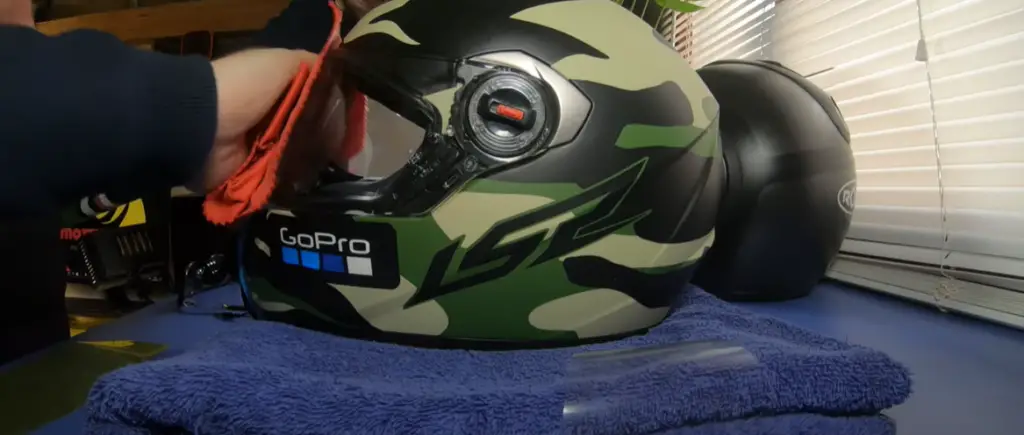
Improved Safety
Tinting motorcycle visors can improve safety by providing greater visibility when riding in poor weather or at night. The darker tint allows riders to see more clearly without having to squint or strain their eyes under low-light conditions. This can help reduce the risk of accidents and increase overall safety on the road.
Protects Against UV Light
Tinted visors also offer superior protection against harmful UV light. This is especially important for those who ride frequently, as the sun’s ultraviolet rays can cause long-term damage to the eyes and skin over time. Tinting motorcycle visors help riders enjoy their rides without worrying about damaging their vision or skin.
Added Style
Tinting motorcycle visors can add an extra bit of style to a bike while also offering added protection. Many riders find that the dark tint provides a cool look that enhances the overall aesthetic of their ride. Additionally, some helmet manufacturers make tinted visors as part of their helmet designs so you can get both style and protection in one package!
Manage Eye Fatigue Better
Tinted visors also help manage eye fatigue better by reducing the amount of glare from the sun and other bright objects. This helps riders stay focused on the road ahead and reduces distractions caused by incoming light beams or reflections from wet surfaces. Additionally, tinted visors can reduce eye fatigue during long rides, making them a great choice for anyone who wants to remain comfortable while enjoying their ride.
Added Durability
Tinted motorcycle visors are known for their durability and resistance against scratches. The dark tint helps protect the lens from abrasive elements that can cause damage over time. This ensures that your visor will last longer and provide superior protection throughout your rides [2]!
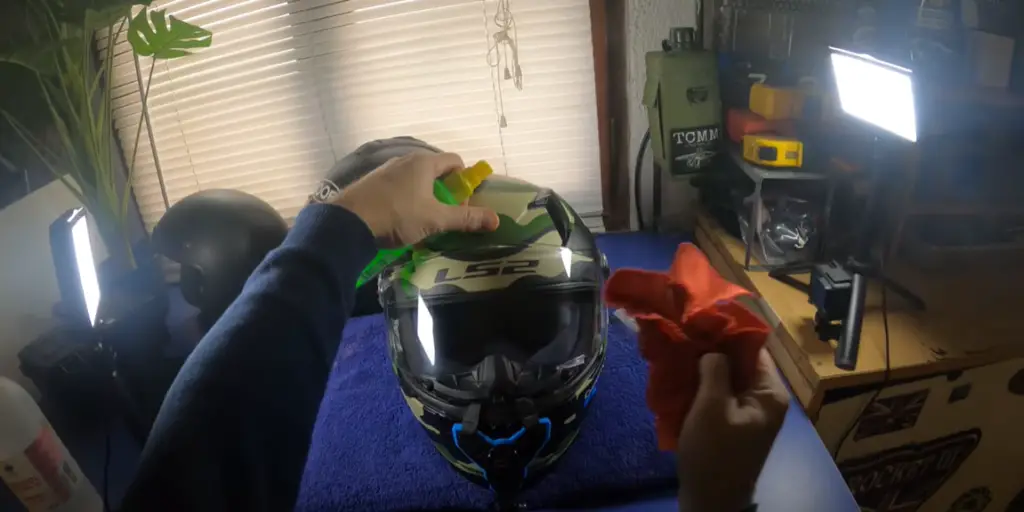
What are the Different Types of Tinting Materials?
The most common type of tinting material is film. This is a thin, adhesive-backed plastic that can be applied directly to the windows. It blocks some levels of light and varies in available shades and hues.
Paint is another popular option for home window tinting, which involves applying a special coating directly to the glass. The paint absorbs some of the sun’s rays, reducing heat gain and glare while allowing natural light through. Paint tints are permanent and offer more flexibility when it comes to color selection since they come in custom colors.
White films are also an option, mostly used on commercial properties or other large windows where completely blocking out light would be undesirable or impractical. Like regular films, white window tinting blocks out UV radiation but still allows a significant amount of natural light to enter the room.
Other types of tinting materials include ceramic films, which are made from metal oxides and offer excellent heat rejection with minimal color distortion. Metallic tints are also available, providing excellent protection from heat and glare while offering more reflectivity than traditional films. These tints come in a variety of shades and hues to suit any decor.
No matter which type of tinting material you choose, it’s important to understand the pros and cons of each option before making a decision. All types can be effective at blocking out harmful UV radiation while still allowing natural light to enter the home or office. Talk with an experienced window tinting professional to get advice on which type is best for your needs [3].
Step-By-Step Instructions To Tint Motorcycle Visor
Step 1: Clean the Visor
The first step to tinting a motorcycle visor is to make sure that it is clean and free of any dirt, dust, or other debris. Use a mild soap and water solution on a soft cloth to gently remove any dirt from the surface of the visor. Make sure that you do not scrub too hard as this could potentially scratch or damage the visor.

Step 2: Apply Tint Solution
Once the visor is clean, you can begin applying the tint solution. Using a spray bottle, mist the entire surface of your visor with an even coat of tinting solution. Follow any instructions given by the solution manufacturer regarding how long you should leave the solution to settle before wiping off any excess liquid.
Step 3: Wipe Off Excess Solution
After the allotted time has passed, take a clean cloth and gently wipe off any excess tint solution from the visor. Make sure to move in circles when doing this so that you do not miss any spots. It is important to remove all of the solution as leaving some behind could potentially cause your visor to be stained or discolored.
Step 4: Allow to Dry Completely
Once you have wiped away all of the excess solutions, set your visor aside and allow it to dry completely before using it on your motorcycle helmet. This could take several hours depending on the type of tinting solution that you used and the conditions in which you left it to dry. Do not attempt to use your visor until it has dried completely and you have tested it to make sure that the tint has adhered properly.
Step 5: Enjoy Your Tinted Visor
Once your visor is dry, you can enjoy the newly tinted look that it gives off! Enjoy riding with your new visor and be sure to take proper care of it so that it continues to look great for years to come. With a few simple steps, you can easily achieve a customized and stylish look for your motorcycle helmet [4].
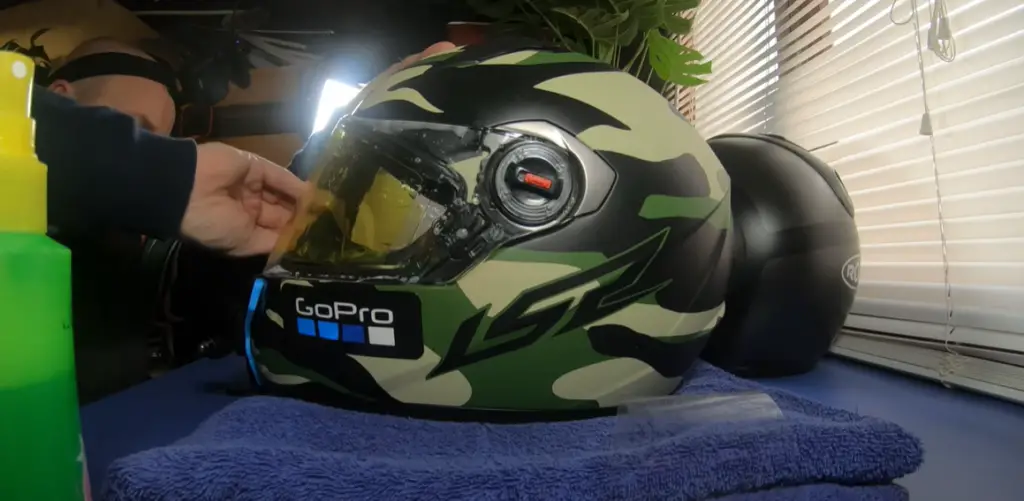
What are the Pros and Cons of a Tinted Visor?
Tinted Visor helmets are often used by motorcyclists to protect their eyes from the sun and wind while riding. The tinted visor can help reduce glare, providing maximum visibility on bright days, and helping riders stay cooler in hot weather.
Pros:
- Reduces glare from the sun and other vehicle headlights
- Enhances vision by increasing visibility on sunny days
- Helps keep riders cool in warm weather with increased airflow
- Can help increase safety by providing better visibility of traffic and road hazards
- Available in a variety of colors and tints for customization options
Cons:
- May impair vision at night or when entering dark tunnels due to lack of light passing through
- Can create a false sense of security as it does not protect the face from flying debris and bugs
- Tinted lenses need to be cleaned often otherwise they will become foggy and impair vision
- Harsh chemicals used to clean tinted visors can cause damage if not used carefully
- Not all tinted visors are approved by safety organizations, so research is necessary before purchasing one.
Overall, a tinted visor could be an advantageous addition for a motorcyclist who frequently rides in bright or sunny conditions. However, riders must weigh the pros and cons when deciding which type of helmet to purchase. Ultimately, personal preference should determine whether a tinted visor is right for you.
FAQ
Can a motorcycle helmet visor be tinted?
Yes, most motorcycle helmet visors can be tinted. However, it is important to check local laws and regulations before doing so as some areas may have restrictions or even outlaw the practice of tinting visors for safety reasons. Additionally, if tinting a visor yourself, make sure to use a high-quality film that is specifically designed for use on helmets to protect your vision from scratches and damage. It is also advised to invest in an anti-fog coating to prevent fogging up of the visor while riding.
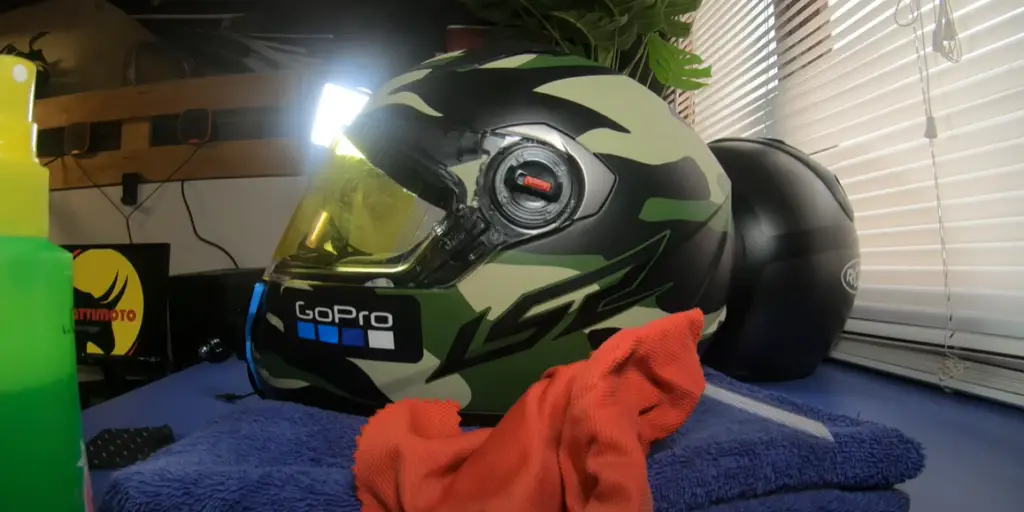
Are there any special care instructions for motorcycle helmets?
Yes, there are several tips you should follow when caring for your helmet:
- Store the helmet at room temperature away from direct sunlight
- Clean the helmet with a damp cloth, avoiding strong detergents or chemical cleaners
- Do not over-tighten the straps when adjusting fit; they should be secure but comfortable
- Avoid dropping or throwing the helmet, as this can damage the lining and cause it to become less protective. Also, try not to leave the helmet in a car trunk as extreme temperatures can affect its quality.
- Inspect your helmet before each ride for any signs of wear and tear, cracks, scratches, loose parts, etc., and replace it if necessary. Regularly inspect all straps for fraying or other signs of damage.
- Make sure to keep all original manufacturer tags attached, as this will help give an accurate description of the helmet in case you ever need to replace it.
- Finally, never use a used or second-hand helmet as this could put your safety at risk.
These are just some of the tips for caring for your motorcycle helmet and ensuring maximum protection while riding. It is important to follow all safety instructions provided by the manufacturer and take into account any local laws and regulations that may affect your choice of protective gear.
Can you put a tint on the helmet visor?
Yes, most motorcycle helmet visors can be tinted. However, it is important to check local laws and regulations before doing so as some areas may have restrictions or even outlaw the practice of tinting visors for safety reasons. Additionally, if tinting a visor yourself, make sure to use a high-quality film that is specifically designed for use on helmets to protect your vision from scratches and damage. It is also advised to invest in an anti-fog coating to prevent fogging up of the visor while riding.
What are the benefits of wearing a helmet?
Wearing a helmet is one of the best ways to protect yourself when riding a motorcycle. Helmets protect against head injuries in the event of an accident, as they absorb and disperse much of the impact energy that would otherwise be transferred to your head. They also provide protection from wind, bugs, dust, and debris while riding. Additionally, wearing a helmet can help reduce noise levels when riding at high speeds. Finally, helmets can act as a deterrent against theft and offer some additional visibility on the road as they are often brightly colored or reflective. All these benefits make wearing a helmet an essential part of staying safe on your motorcycle.
What type of helmet should I buy?
When choosing a motorcycle helmet, it is important to consider factors such as fit, comfort, safety ratings, and budget to find the best option for you. It is recommended to try on several different helmets with different sizes, shapes, and styles to find one that fits your head properly. Make sure the helmet is snug but not too tight and that it does not move around when you turn your head. Additionally, look for helmets with safety ratings from organizations like DOT or SNELL as these indicate a higher level of protection. Finally, consider your budget when buying a helmet; there are many options available in all price ranges so you can find something that meets your needs without breaking the bank.
How do you tint a visor at home?
Tinting a visor at home can be done with a special film designed for motorcycle helmets. It is important to make sure the helmet is clean and free of dust before applying the film, as this will ensure a smooth result. Start by marking out the area where you want to apply the tint using painter’s tape or another type of adhesive masking material. Cut out the desired size and shape of your tint, then use water or an application solution to dampen the interior surface of your helmet visor. Peel off the backing from your tint and carefully apply it to the visor in a smooth motion, starting from one corner and working across.
Does tinting a motorcycle visor invalidate your insurance?
No, tinting a motorcycle visor should not invalidate your insurance provided that you are compliant with any local laws and regulations regarding tinted visors. It is important to check the specific laws in your area before applying the tint as some jurisdictions may have restrictions on the amount of tint that can be applied to protect rider visibility. Additionally, make sure to use a high-quality film specifically designed for helmet visors and always follow all instructions provided by the manufacturer when installing it.
Are there any drawbacks to tinting motorcycle visors?
Although tinting a motorcycle visor can provide some benefits such as reducing glare, it also has some potential drawbacks that should be taken into consideration. The added dark tint can obscure your vision and limit visibility when riding on roads with low light or in certain weather conditions. Additionally, the tint may fade over time due to exposure to sun and other elements and require regular maintenance. Finally, if applied incorrectly or using poor-quality film, there is a risk of bubbles, scratches, or other damage to the visor which could compromise safety. As such, it is important to do your research and understand all associated risks before deciding whether or not to tint your visor.
Can I use a pin-lock with a tinted visor?
Yes, you can use a pin-lock with a tinted visor as long as the tinting is done correctly and applied to the interior surface of the visor. The key is to make sure that the tint does not interfere with the locking mechanism of your helmet or obstruct any vents or airflow. Additionally, it is important to check local laws and regulations regarding tinted visors before applying any film. By taking these precautions, you should be able to use a pin-lock with a tinted visor without compromising safety or performance.
Can I spray tint a motorcycle visor?
No, it is not recommended to spray tint a motorcycle visor. This method does not provide the same level of protection as a proper film application and can create air bubbles or imperfections that can hinder visibility or cause damage to the visor over time. Additionally, many states have laws prohibiting the use of spray-on tinting for helmets due to safety concerns. It is best to use a quality film specifically designed for motorcycle helmet visors which will adhere properly without leaving any residue when removed.
Useful Video: HOW TO TINT A VISOR
Conclusion
Tinting a Motorcycle Helmet Visor can have its advantages and disadvantages, depending on the user’s needs. Tinting a visor is especially beneficial for those who ride in bright or sunny conditions, as it can reduce glare while still protecting from debris and impact. However, it is important to consider that a tinted visor may be less visible at night or when riding in overcast weather. Additionally, riders should also be aware of any laws that may restrict helmet visor tints in their area. Ultimately, each rider needs to decide if tinting a motorcycle helmet visor is right for them based on their individual preferences and circumstances.
References:
- https://www.streetdirectory.com/travel_guide/56127/motorcycles/what_you_should_know_about_motorcycle_helmet_visor.html
- https://www.studds.com/blog/what-is-a-tinted-visor-and-why-do-you-absolutely-need-it
- https://www.deansautoglass.com.au/blog/automotive/the-different-types-of-car-window-tinting-and-their-benefits/
- https://www.bikersrights.com/how-to-tint-motorcycle-visor/

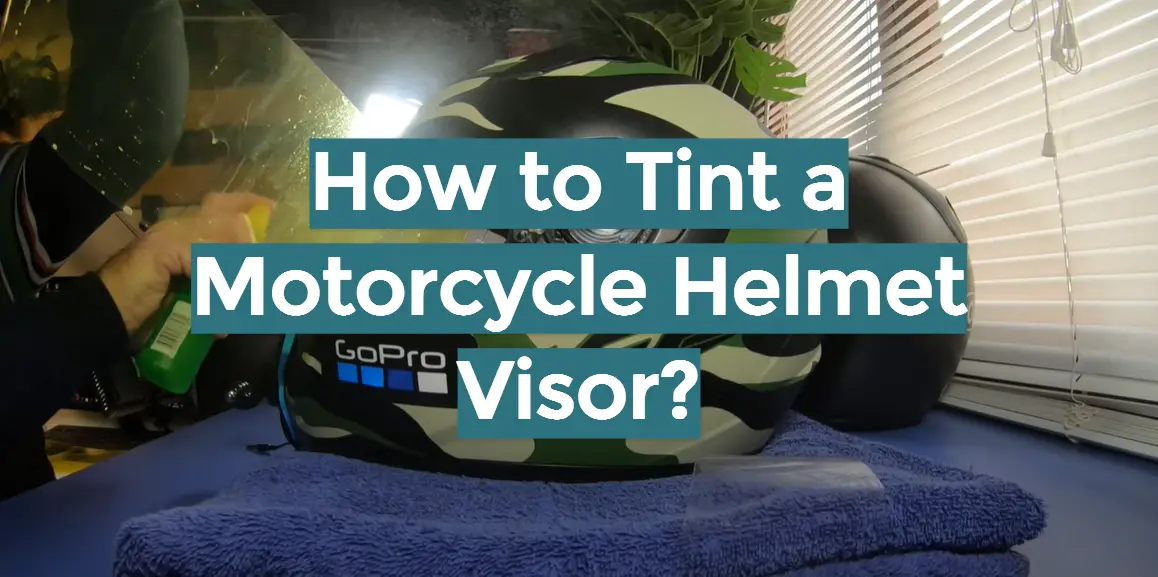

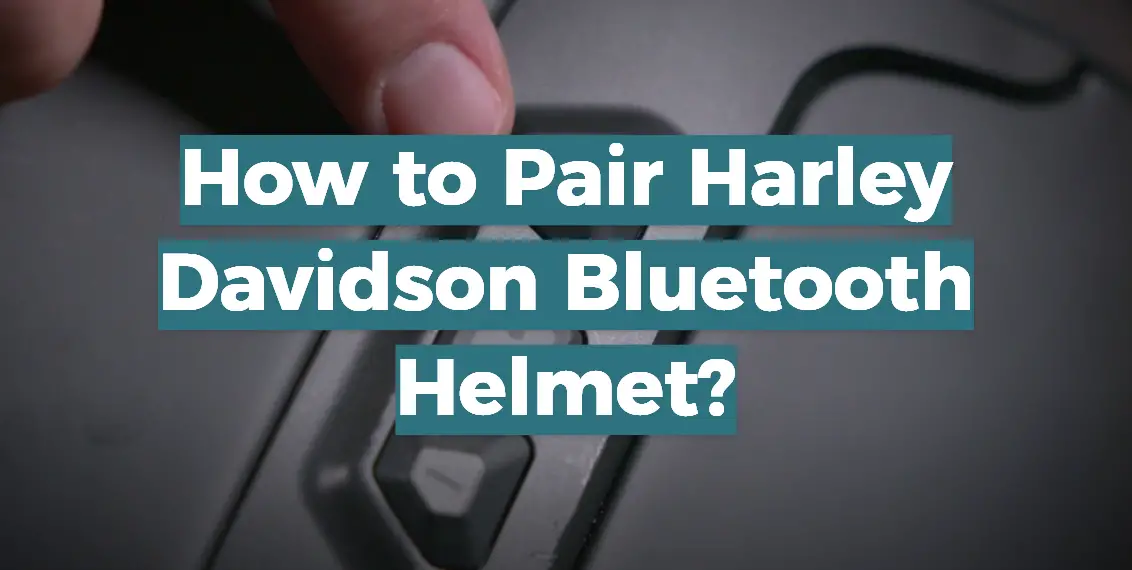


Leave a Reply